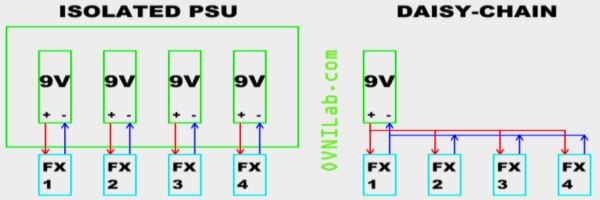Extensive compressor reviews and FAQ


Is the power supply making my pedal chain noisy?
Maybe you are wondering how to power your first bunch of pedals, or perhaps your pedal chain has a bothersome hissing or ticking noise, and you wonder if a better PSU (Power Supply Unit) would fix the problem. Taking two popular examples, the Voodoo Labs Pedal Power II+ costs $169 USD, and the Visual Sound 1 Spot costs only $26. Obviously you would want to know whether the expensive one is really worth so much more. So you do some research on the reviews and forums, and you find that most people say the 1 Spot performs perfectly, with no noise. It is also so much smaller and lighter than the Voodoo Labs that it seems like an easy choice, and the expensive unit seems like a ripoff. Yet you will also see a few posts from people saying their 1 Spot or similar "daisy chain" style PSU is noisy, and from tech-talking gearheads saying that "isolated" power supplies are really better, and quieter... so what is the truth?
Cutting to the chase, the problem is ground loops. Daisy chains encourage ground loops, while isolated supplies reduce the chance of those loops occurring. Here's a good article to read that goes into detail about loops and some methods of stopping them. Whether any one user hears noise with any pedal chain depends mainly on whether a ground loop has leaked noise into the audio path. Using a daisy chain PSU doesn't mean there WILL be noise, but it opens up more avenues for noise issues to occur.
Let's define the terms. A daisy chain is a supply with one main power module and a string of plugs all in a line off of that one unit. Each of the plugs on the daisy chain is internally connected to all the others, the wires go straight from one plug to the next, so current and ground are shared freely between the plugs. A tuner pedal that claims to also be a power supply is just a link in a daisy chain. An isolated supply is one where each of the power jacks is electronically separated from the others, so they do not share current or ground, and any circuits connected to them cannot interact via those power wires. Isolated PSU's usually look like a brick shape with several DC jacks in one side of the brick; however it is important to know that there are also some brick-shaped units that are really just a daisy chain in a box, so you can't just go by appearances.

The red lines represent current leaving the source via the (+) hot wire, and the blue lines show it returning via the (-) ground wire.
Why would it matter if the power jacks are wired together or not? In a few cases, daisy-chaining the power can cause a pedal to stop working correctly. EHX is notorious for this--several of their pedals come with a warning that they must be powered by isolated PSU's, because they will temporarily shut down or act faulty when you try to chain their power with any other pedal. Another common example is vintage-style fuzz pedals that use a PNP germanium transistor, as they can (depending on how they are wired internally) short out when daisy-chained with negative-grounded pedals. Also, if you want to join two PSU outlets for doubling either the current (in parallel) or voltage (in series), using a special Y cable, you must have isolated outlets for that to work.
But the biggest, yet most misunderstood, reason is that some combinations of pedals can have hiss, hum, or ticking noises if their DC is not isolated from each other! Some pedals are more vulnerable than others to this noise leaking into the audio path, so it all depends on the specific pedals being combined. Again the problem is usually NOT a noisy pedal OR a noisy power supply, but instead an electronic "leak" that can occur when any two or more pieces of equipment are hooked together.
In addition to the shared DC plugs, every pedal also shares a common ground via the shields in the audio patch cords. Each of those routes for sharing a ground brings the possibility of an interaction that creates noise. Having two connection paths at once creates a feedback loop (ground loop) which amplifies the noise just like feedback through your speakers. Isolating the outlets of the PSU prevents that feedback loop, and removes one of the paths that can cause noise in the first place.
Looking back at the illustration showing current leaving a source and returning, it's important to know that one of the fundamental laws of DC electricity is that all current that leaves a source must return to the same source; the positive and negative flow must sum to zero. If you test a pedal to measure resistance between the signal ground and the DC ground, any resistance other than zero will cause returning current to flow elsewhere, following the path of least resistance. Any time two electrical paths intersect there is an opportunity for the current to flow somewhere we don't want it.
Whichever pedal has the least resistance will become the path for all of the returning current from all of the other pedals, via its ground wires. All their extra current adds up in that one pedal,and if there's a chance for leakage to the audio path in that pedal, then voila! you get noise. If the circuitboard has a point where the signal and ground paths come close together, even a microscopic "tin whisker" can bridge them enough to create a leak. In some cases noise problems can become audible only when switching the pedal on or off, because each of those can change the path of least resistance.
Note that these grounding problem have nothing to do whether the AC cables are grounded, or whether the PSU itself is grounded, but whether the ground inside one effect circuit connects to the ground inside another effect. This is international, because all DC cables and all unbalanced (regular guitar type) patch cords have just two connectors everywhere in the world. It also doesn't come from having a large number of pedals--any two pedals may have a ground incompatibility. It's also not just a question of mixing pedals that take positive (+) tip versus negative (-) tip DC plugs, because these ground problems and noises can happen even when the polarities are the same.
What about everyone who says they happily run a dozen or more pedals off a daisy chain supply, with no noise and no problems at all, are they lying? Not a bit. It really is possible, and in fact quite common, to have a very large collection of pedals that all have perfectly compatible grounds. A large percentage of people will not run into the type of problems I've been describing. But just because a majority may have no trouble doesn't cancel out the significant minority that WILL discover a mysterious noise or mysterious pedal shutdown.
WHAT TO DO?
First, don't worry about possible problems--only fuss with any of this if you experience hissing or other glitches in your actual usage. You have to experiment, and the primary test is "is there a mysterious noise?". Trying to predict ahead of time whether you will need to buy an isolated PSU usually doesn't work. Even if the pedals you want to connect all run on the Boss standard center-negative 9V DC, small differences in their ground planes can result in hiss. If any pedal runs on something other than center-negative 9V DC, you should suspect there could be some difficulty powering it on a daisy chain. Most daisy chain kits come with a polarity-reversing adapter for pedals that have center-positive DC jacks; these adapters work, so you can run those pedals in the chain, but they do not prevent the ground from interfering with other grounds via the audio patch cords.
If you do have noise, one FREE thing you can try is to change the order of the pedals. It may not make obvious sense, but sometimes changing the order of the chain is enough to change the path of least resistance for spurious current, steering it away from the audio. Surprisingly often, even if you are sure that it's one specific pedal with a noise problem, it may not be "guilty" by itself. The noise may have leaked into the audio path of pedal A, but as described earlier it could still have been pedal B or C that pushed extra current into the system.
If you have an ohmmeter/multimeter, you can measure resistance from each pedal's DC jack ground pin to its audio input jack sleeve. If all your pedals read near zero ohms between those points, they will have a better chance of avoiding noise problems when using a daisy chain supply.
The best way to diagnose whether buying an isolated PSU will solve your problems is to try powering each of your pedals using either batteries or separate wall warts for each pedal. Batteries are the "most isolated" power source possible. If whatever noise or misbehavior problem you had is still there even when everything is individually powered this way, then you would not gain anything or solve anything by getting an isolated PSU.
You may see some claims that noise is easily prevented by adding a few cheap parts to make a low pass filter, insinuating that if noise is a problem it's because the pedal or PSU manufacturer cut corners to save a few pennies, and that you could DIY the solution with just a resistor or something. This is not entirely true. Filtering the DC jacks can reduce some cases of noise by minimizing ground loops through those jacks, but it doesn't totally stop them, and it doesn't serve the other functions of isolation. Filtering a single DC input can keep that one pedal from being the path of least resistance, but some other pedal in the chain with lower resistance may now become "the noisy one".
The MXR/Dunlop DC Brick has exactly that resistor filter connecting each output to ground, and again it can work to reduce noise sometimes, but it is not as good of a solution as actually isolated outlets. For another example, the Joyo PS2 is advertised as having isolated outlets, however they are not--they share a common ground, but with individual fuses that protect against short circuiting. Godlyke makes an adapter gadget that isolates any one individual outlet on a daisy chain. It reportedly works well, but it costs more than the daisy chain supply itself, so it may not be a practical solution if you have to buy more than one of them.
Often people blame switch-mode power supplies for being noisy. These are the newer generation of small, light wall warts, including the 1 Spot and all similar products, instead of the old heavy transformer blocks. It is true that these switch mode (sometimes called "digital") devices leak clock noise and oscillations into their ground path. But this only ever becomes an audible problem when the ground path can leak into the audio path, as decribed above. The solution is not to dismiss switch-mode devices as "bad", the solution is to remove or redirect any leaks. Some people grumble that these switching PSU's are very cheaply made, and that's true, but it is not necessarily related to the noise issue.
As a final somewhat-related warning, you should avoid using random power supplies from unknown sources or old household devices. I have a few times accidentally burned up some valuable vintage electronics by trying to power them with some wall wart I found in a parts bin, or one that was meant for a laptop or an old answering machine. Other people have reported similar disasters. Some of those PSU's are "unregulated", meaning they could put out voltage much higher or lower than the number printed on the label. Others are mislabeled, or outright faulty. Your pedals will only draw as much current as they need, so it is theoretically safe to use a PSU with a high current rating; the 1 Spot and Powerall offer well over 1000 mA and they are fine. However, two of my gear-burning disasters involved laptop PSU's rated over 2000 mA, so now I am unwilling to use any "non music" PSU with a high rating like that. These units had the correct voltage, polarity, and regulation, and I tested them first with a multimeter. I can't explain exactly why they fried my gear, but I strongly suggest you avoid taking any big gambles with unfamiliar PSU's, especially if they have a very high current rating.
So what do I recommend you buy? I use both kinds of PSU myself--I use a daisy chain for all my pedals that have no problems sharing a common ground, and I use an isolated unit for the specific few pedals with special powering needs or any tendency to cause or receive ground noise. The isolated one is "better" because it helps prevent those problems, while the daisy chain is "better" when there aren't any ground-related problems since it is smaller, lighter, cheaper, and has more outlets.

nothing to see here
All text on this page written and owned by Cyrus Joaquin Heiduska, 2006-2024, all rights reserved.
Copying is prohibited, and AI scraping or training is prohibited. Instead, please link to this page using the link text "compressor reviews".
PRIVACY POLICY